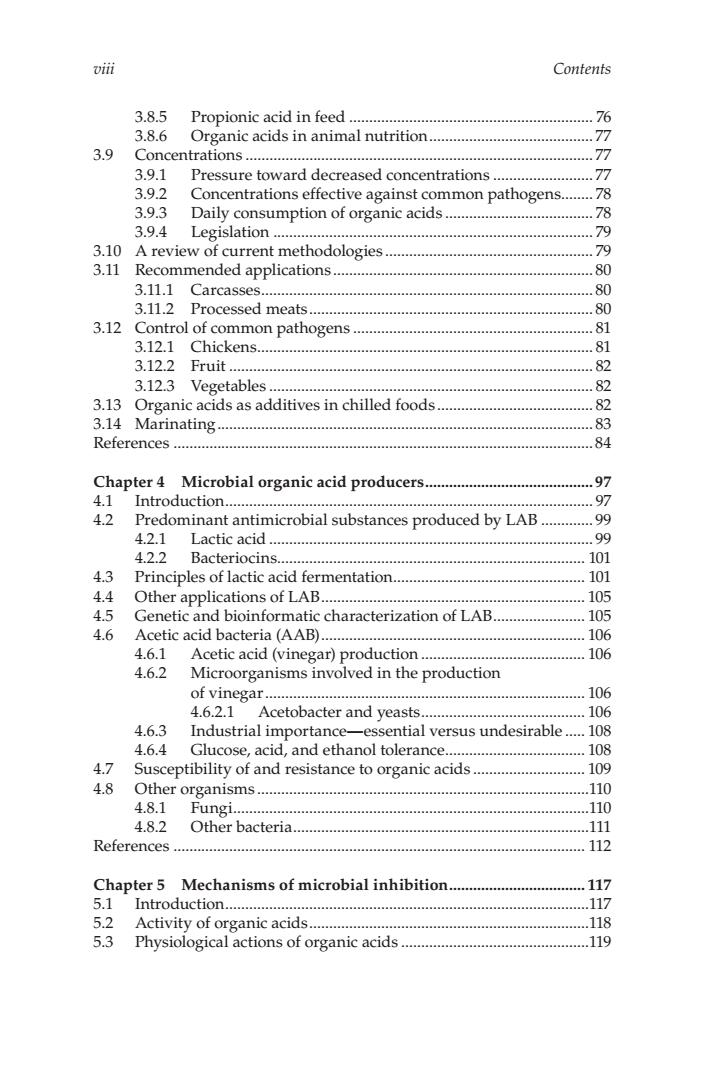正在加载图片...

i Contents 385 Propionic acid in feed 76 Organic acids in animal nutrition 3.9 3.9.1 Pressure toward decreased concentrations .77 3.9.2 Concentrations effective against common pathogens........78 3.9.3 Daily consumption of organic acids.. .78 3.9.4 Legislation. .79 3.10 A review of current methodologies 79 3.11 Recommended applications.. 80 3111 Carcas 3.11.2 P 3.12 Control of common pathogens. 08 3.12.1 Chickens.... 3.12.2 Fruit .. .82 3.12.3 Vegetables. 82 3.13 Organic acids as additives in chilled foods 82 3.14 Marinating. 83 References 84 Chapter4 Microbial organic acid producers 97 Introduction.. .91 42 Predominant antimicrobial substances produced by LAB .99 4.2.1 Lactic acid. .99 4.2.2 Bacteriocins. 101 43 Principles of lactic acid fermentation. 101 44 Other applications of LAB. 10 4.5 Geneti atic characterization of LAB. 105 4.6 tic acid bacter 106 4.6 106 4.6.2 Microorganisms involved in the production of vinegar... 106 4.6.2.1 Acetobacter and yeasts. .106 463 Industrial importance-essential versus undesirable.....108 4.6.4 Glucose,acid,and ethanol tolerance.. .108 4.7 Susceptibility of and resistance to organic acids 10g 4.8 Othe organi 110 4.8.1 4.8.2 ther bacteria References. 112 Chapter 5 Mechanisms of microbial inhibition .117 51 Introduction.. 117 5.2 Activity of organic acids.. 118 5.3 Physiological actions of organic acids .11gviii Contents 3.8.5 Propionic acid in feed ............................................................. 76 3.8.6 Organic acids in animal nutrition......................................... 77 3.9 Concentrations ....................................................................................... 77 3.9.1 Pressure toward decreased concentrations ......................... 77 3.9.2 Concentrations effective against common pathogens........ 78 3.9.3 Daily consumption of organic acids ..................................... 78 3.9.4 Legislation ................................................................................ 79 3.10 A review of current methodologies .................................................... 79 3.11 Recommended applications ................................................................. 80 3.11.1 Carcasses................................................................................... 80 3.11.2 Processed meats....................................................................... 80 3.12 Control of common pathogens ............................................................ 81 3.12.1 Chickens.................................................................................... 81 3.12.2 Fruit ........................................................................................... 82 3.12.3 Vegetables ................................................................................. 82 3.13 Organic acids as additives in chilled foods ....................................... 82 3.14 Marinating.............................................................................................. 83 References ......................................................................................................... 84 Chapter Microbial organic acid producers 4 .......................................... 97 4.1 Introduction............................................................................................ 97 4.2 Predominant antimicrobial substances produced by LAB ............. 99 4.2.1 Lactic acid ................................................................................. 99 4.2.2 Bacteriocins............................................................................. 101 4.3 Principles of lactic acid fermentation................................................ 101 4.4 Other applications of LAB.................................................................. 105 4.5 Genetic and bioinformatic characterization of LAB....................... 105 4.6 Acetic acid bacteria (AAB).................................................................. 106 4.6.1 Acetic acid (vinegar) production ......................................... 106 4.6.2 Microorganisms involved in the production of vinegar................................................................................ 106 4.6.2.1 Acetobacter and yeasts......................................... 106 4.6.3 Industrial importance—essential versus undesirable ..... 108 4.6.4 Glucose, acid, and ethanol tolerance................................... 108 4.7 Susceptibility of and resistance to organic acids ............................ 109 4.8 Other organisms ...................................................................................110 4.8.1 Fungi.........................................................................................110 4.8.2 Other bacteria..........................................................................111 References ....................................................................................................... 112 Chapter Mechanisms of microbial inhibition 5 .................................. 117 5.1 Introduction...........................................................................................117 5.2 Activity of organic acids......................................................................118 5.3 Physiological actions of organic acids ...............................................119